ABSTRACT
Scaling up the production capacity of spark discharge generated nanoparticles is crucial for their industrial application. Among various options, high-frequency spark discharge generation is a promising route as the mass production rate of nanoparticles should simply scale linearly with the spark frequency. However, reports of spark discharge generators operating above 1 kHz are scarce in the literature, as spark discharges at higher frequencies have been observed to be irregular, leading to premature spark discharges that result in a significantly lower mass production rate. In this study, we present a wire-to-plate electrode configuration that suppresses premature spark discharges during high-frequency operations above 1 kHz, and investigate the factors that contribute to the occurrence of premature spark discharges by comparing the performance of the wire-to-plate electrode configuration to those of rod-to-rod and wire-to-rod configurations. We identified that spark duration should be minimized to achieve stable spark discharge events as it correlates to the time required for the spark plasma to be completely removed from the spark zone, and found that increasing local electric field intensity and carrier gas velocity are both beneficial to achieving stable high frequency spark discharges. Lastly, using the wire-to-plate electrodes, we show that stable operation without premature spark discharges can be achieved up to 17.9 kHz and the copper nanoparticle production rate scales as expected (up to 7.6 mg/h) when premature spark discharges are eliminated during high frequency operations.
Copyright © 2017 American Association for Aerosol Research
EDITOR:
Introduction
Spark discharge generation (Schwyn et al. Citation1988) is a simple, clean, and energy efficient method for producing nanoparticles in gas phase media (Borra Citation2006; Meuller et al. Citation2012; Park et al. Citation2014; Tabrizi et al. Citation2009), and the nanoparticles generated by this method have been utilized in various applications for their unique optical, electrical, and catalytic properties. For example, gold nanoparticles produced by the spark discharge method were employed in organic light emitting diode devices to enhance their quantum efficiency (Sung et al. Citation2014) and used as seeds for nanowire growth (Messing et al. Citation2009). In addition, charged nanoparticles produced from spark discharges can be directed via electrostatic field and assembled into complex three-dimensional nanostructures which can be utilized for various applications; for example, in surface-enhanced Raman spectroscopy (Jung et al. Citation2014; Lee et al. Citation2010), gas sensing (Lee et al. Citation2010) and photovoltaics (Ha et al. Citation2016; Jang et al. Citation2016; Kim et al. Citation2015).
To integrate spark discharge-generated nanoparticles into industrial applications, the ability to scale up the manufacturing process in a uniform and stable manner is essential. There are many ways to increase the production rate of a single set of electrodes, one of which is to increase the spark frequency. Each spark discharge can be thought of as a unit event that generates a certain amount of nanoparticles, and the production rate is expected to scale linearly with the spark frequency. In reality, this is not the case as at high frequency regime above 1 kHz, premature spark discharges occur intermittently, resulting in a production rate that is lower than expected (Pfeiffer et al. Citation2014). Of note, a recent review article by Pfeiffer et al. (Citation2014) has demonstrated spark stability up to 20 kHz by adding fast switching electronic components to the conventional circuit to prevent premature spark discharges and to regulate the spark duration.
In this study, we sought to stabilize the spark discharge process at high frequencies by first determining the factors which affect the spark stability. We hypothesized that the residual spark plasma is the cause of premature spark discharges, and hence developed a wire-to-plate electrode configuration (Maisser et al. Citation2015) which has increased local carrier gas flow velocity and electric field intensity around the spark zone, both of which are expected to contribute to fast removal of spark plasma generated by the preceding spark event. The maximum stable spark frequency and spark duration of wire-to-plate electrodes were compared against those of rod-to-rod and wire-to-rod electrodes and the effect of the electric field intensity and gas velocity were confirmed separately. Then, the nanoparticle production rates were quantified for high frequency operations to confirm that the production rates scale up as expected. Lastly, changes in size distributions depending on the operation frequency are noted and its implications are discussed.
Experimental methods
The experimental setup shown in was used to generate nanoparticles and measure the size distribution of the produced nanoparticles as well as to measure the voltage and current at the electrodes during the process.
Figure 1. Schematics of (a) experimental setup (showing wire-to-plate electrode configuration as an example), and three different electrode configurations (b) rod-to-rod, (c) wire-to-rod, and (d) wire-to-plate. Arrows in (b)–(d) indicate carrier gas inflow.
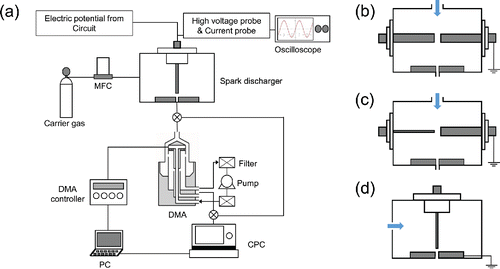
The “conventional” circuit was used to control the spark discharge (Chae et al. Citation2015; Han et al. Citation2012), comprising a high voltage power source (HVPS, FuG HCP 350–12500), a resistor (200 or 400 kΩ) and a capacitor (1, 2 or 3 nF). The spark frequency was controlled by varying the voltage input from the HVPS and the resistance of the circuit, while other parameters (discharge voltage, mass flow rate of carrier gas and capacitance of the circuit) remained unchanged. An oscilloscope (Agilent DSO-X 3014 A) equipped with a high voltage probe (Tektronix P6015A) and a current probe (Agilent 1147A) was connected to the anode for voltage and current measurements.
The spark discharger was constructed using a custom cylindrical chamber (122 cm3 volume, 50 mm inner diameter, 62 mm in height). Three different electrode configurations were used in this study: rod-to-rod (), wire-to-rod () and wire-to-plate (). Copper rods (diameter, d = 7 mm) and wires (d = 1 mm) were used as electrodes for rod-to-rod and wire-to-rod configurations, and were installed horizontally and coaxially within the spark discharge chamber. For the wire-to-plate type electrode configuration, a copper wire (d = 1 mm) electrode was installed vertically on a holder and aligned to the central axis of the chamber. Then, a copper ground plate (which also serves as the cathode in this configuration) with a 0.5 mm diameter hole was mounted underneath the wire such that the hole is coaxially aligned with the wire electrode.
For all experiments, nitrogen (99.999% purity) was used as the carrier gas, and its flow rate was controlled using a mass flow controller. The gas flow was directed such that it enters through the chamber inlet and exits through the hole (d = 0.5 mm) in the copper ground plate (In the rod-to-rod and wire-to-rod cases, the plate was still mounted to the chamber to keep the flow conditions the same as the wire-to-plate case.). The anode (wire electrode in the wire-to-rod configuration) was connected to the spark control circuit, and the cathode was connected to the ground. The gap between the electrodes was adjusted to set the discharge voltage at 2.2 kV.
The particle size distribution measurement system consists of a differential mobility analyzer (DMA, TSI 3085), a DMA controller (TSI 3776), and a condensation particle counter (CPC, TSI 3776). The DMA and CPC were used in conjunction to quantify the nanoparticles generated from the spark discharger in the range of 4–150 nm, and to obtain the particle size distribution.
Results and discussion
For a spark discharge to occur, the voltage across the electrodes must exceed the breakdown voltage of the medium between them. Once the voltage exceeds the threshold value, dielectric breakdown of the medium occurs, and spark plasma is generated which completes the circuit and a current flows through the gap between the electrodes. Once the capacitor is discharged completely, the cycle starts again.
To determine the stability of the spark events, we monitored the voltage profiles across the spark electrodes using an oscilloscope and a high voltage probe. depicts an exemplary voltage profile of a stable spark discharge process with rod-to-rod electrodes where the spark discharge events occur at the desired voltage (∼2.2 kV) consistently at a frequency of 1.1 kHz. When the spark frequency is increased to approximately 3.7 kHz, premature spark discharge events occur and spark discharge voltages as low as 600 V were observed (). The premature spark discharge occurs due to reduced breakdown voltage of the medium caused by residual space charge coming from the spark plasma that has not been completely removed (Pfeiffer et al. Citation2014). Therefore, to prevent premature spark discharges (or at least increase the onset frequency), it is necessary to restore the medium to its “normal” state as quickly as possible before the next spark discharge event. The time needed for complete removal of the plasma may depend on a number of factors, such as the electrode geometry and configuration, carrier gas velocity and the spark discharge voltage.
Figure 2. Voltage profiles from rod-to-rod electrode type spark discharger. (a) Frequency of 1.1 kHz. (b) Frequency of 3.7 kHz; unstable state with discharge voltages below the desired breakdown voltage (2.2 kV).
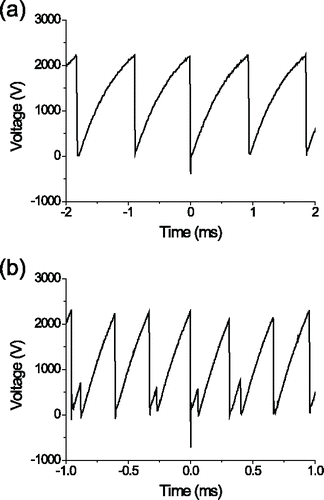
Three electrode configurations were examined to identify the factors that affect the spark stability: rod-to-rod, wire-to-rod and wire-to-plate. Using 6.7 lpm of carrier gas flow, the maximum stable spark frequency was 1.1 kHz for rod-to-rod configuration, 2 kHz for wire-to-rod configuration, and 17.9 kHz for wire-to-plate configuration. This can be understood in terms of how fast the spark plasma is removed, and the medium returns to the “normal” state. Indeed, at spark frequency of 1 kHz and carrier gas flow rate of 6.7 lpm, the voltage and current profiles of the three configurations show that the spark duration (defined as time for voltage/current oscillation to completely decay) is 5.45, 5.05, and 4.78 µs for rod-to-rod, wire-to-rod and wire-to-plate configurations, respectively (), where shorter duration is indicative of faster plasma removal. The differences in spark duration can be qualitatively explained by electrical repulsion from the high-intensity electric field and physical removal by the local carrier gas flow. The rod-to-rod and wire-to-rod configurations have similar local carrier gas velocity due to their geometric similarity, but the wire electrode in wire-to-plate configuration produces larger electric field intensity because of its thinner diameter, and hence the plasma is displaced faster by electrical repulsion. The wire-to-plate spark discharge generator was able to produce regular sparks at the highest frequency, which can be attributed to the fast local flow velocity near the spark region, in addition to the high electric field intensity arising from the wire electrode (Han et al. Citation2012).
Figure 3. Current and voltage profiles during spark discharge events at 1 kHz spark frequency. (a) Rod-to-rod, (b) wire-to-rod, and (c) wire-to-plate electrode configuration.
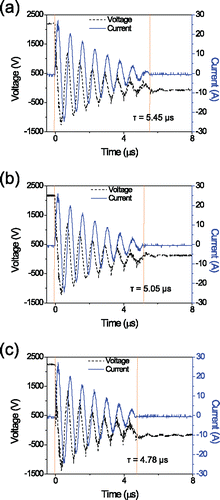
To validate the role of electric field intensity in spark discharge stabilization, we have measured the spark duration at different frequencies at a fixed carrier gas flow rate of 6.7 lpm (). The average spark duration time decreased from 4.78 to 2.05 μs as the spark frequency increased from 1 kHz to 17.9 kHz. As faster restoration of the electrode potential leads to stronger electric field intensity, this result indicates that higher intensity electric fields help remove plasma faster, and thereby help stabilize the spark discharge process at high frequencies.
Figure 4. (a) Spark duration time of wire-to-plate electrode type spark discharger as spark frequency increases (Capacitance 1nF), breakdown voltage 2.2 kV, N2 flow rate 6.7 lpm. (b) Voltage profiles during spark discharge events at 1.1 kHz and 17.9 kHz.
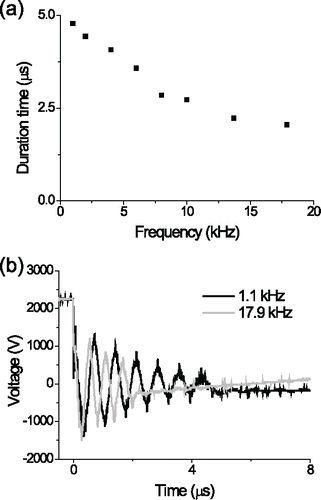
To confirm that the faster carrier gas flow helps stabilize spark events at higher frequencies, the voltage profiles for wire-to-plate electrodes set up for 14 kHz spark frequency using flow rates of 4.1 and 6.7 lpm were compared. At 4.1 lpm, premature spark discharges below the desired voltage of 2.2 kV occurred intermittently because the slow carrier gas flow was unable to eliminate the plasma between the electrodes (). At 6.7 lpm, the spark events occurred regularly, discharging at the desired voltage of 2.2 kV (). These results show that the faster carrier gas flow rate is indeed beneficial for high frequency operation of spark dischargers.
Figure 5. Voltage profiles from wire-to-plate electrode type spark discharger with frequency of 14 kHz with carrier gas (N2) flow rates of (a) 4.1 lpm and (b) 6.7 lpm. Mass production rate of nanoparticles (Cu) scale linearly with (c) spark frequency (Capacitance 2 nF), up to the maximum stable spark frequency, and (d) external capacitance, at spark frequency of 10 kHz and flow rate of 6.7 lpm.
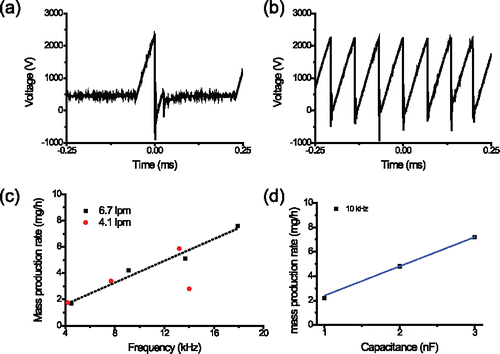
In addition to the stability of the spark events, we quantified the production rates of nanoparticles at different carrier gas flow rates. We chose the mass production rate to represent the production rate of nanoparticles, which can be approximated by the electrode ablation rate. The electrode ablation rate was measured by weighing the electrodes before and after spark discharge operations. The mass production rate should increase linearly with the spark frequency, as long as premature spark discharges do not occur. Indeed, it is seen that with 4.1 lpm of carrier gas flow, the mass production rate linearly increases with the frequency, up until ∼14 kHz, after which premature spark discharges develop and the mass production rate drops off sharply. On the other hand, with 6.7 lpm flow, the mass production rate continues to increase linearly all the way up to 17.9 kHz (). The mass production rates measured within stable spark frequency range were consistent irrespective of the carrier gas flow rate, which means that electrode ablation does not significantly depend on the carrier gas flow. The mass production rate also showed linear dependence on the circuit capacitance as expected (), and this shows that increasing the spark energy does not interfere with the spark stability. The electrode ablation efficiency was calculated to be 0.234×10−7gJ−1 based on the total energy stored in the capacitor before discharge.
Lastly, the particle size distributions were measured for spark frequencies of 4.5, 9.1, and 17.9 kHz to observe the effect of changing the spark frequency, while the carrier gas flow rate was kept at 6.7 lpm. show that the spark events are indeed stable for the tested frequencies of 4.5, 9.1, and 17.9 kHz, respectively. The geometric mean diameters were 11.0, 21.5, and 36.7 nm and the standard deviations were 1.40, 1.48, and 1.50, respectively. While the increase in spark frequency in a stable spark event leads to a linear increase in the mass production rate, the total number concentration and the mean particle diameter also increases with little changes to the standard deviation. This is expected as the flow conditions around the electrodes remain the same, while increased spark frequency would vaporize more material in a given time, increasing the concentration of primary particles that later agglomerate leading to larger mean particle agglomerate diameters (Tabrizi et al. Citation2009). This suggests that the particle size distributions of the aerosol can be tuned according to the intended application either by increasing the gas flow rate (above the minimum gas flow rate that ensures stable high frequency operation) or by adding a clean gas flow (dilution) downstream of the spark generator.
Figure 6. Voltage profiles from wire-to-plate electrode type spark discharger at different frequency: (a) 4.5 kHz, (b) 9.1 kHz and (c) 17.9 kHz. (d) Size distribution of generated nanoparticles at each frequency showing increasing geometric mean diameter and total number concentration as the frequency increases. The energy per spark and the gas (N2) flow rate are 4.84 mJ and 6.7 lpm in all the cases.

Conclusions
We have developed a high frequency spark discharge generator using wire-to-plate electrode configuration that enables fast removal of spark plasma and compared its performance to rod-to-rod and wire-to-rod electrode configurations to identify process parameters that determine the maximum stable spark frequency that can be achieved. By observing the current and voltage profiles of the spark discharge events, rapid plasma removal characterized by short spark duration was identified as an important feature of stable spark discharges at high frequencies for our wire-to-plate electrode spark discharger. High-intensity electric fields and fast carrier gas flows within the spark zone were both found to contribute to faster plasma removal, and therefore to stable high frequency operation. Among the three electrode configurations compared, wire-to-plate electrodes were best suited to implement both means, achieving spark stability up to 17.9 kHz. Using the wire-to-plate electrodes, it was shown that the mass production rate of nanoparticles indeed scale linearly with the spark frequency, as long as no premature spark discharges occur, in which case the mass production rate drops off sharply. Increasing the spark frequency leads to particle agglomerates of increasing mean diameter, and hence appropriate measures should be taken when designing large industrial-scale spark discharge generators for production of nanoparticles with a specific size distribution.
Funding
This work was supported by the Global Frontier R&D Program on Center for Multiscale Energy System (Grant no. 2011-0031561 and 2012M3A6A7054855) by National Research Foundation (NRF) under the Ministry of Science, ICT and Future Planning, Korea.
References
- Borra, J.-P. (2006). Nucleation and Aerosol Processing in Atmospheric Pressure Electrical Discharges: Powders Production, Coatings and Filtration. J. Phys. D: Appl. Phys., 39:R19.
- Chae, S., Lee, D., Kim, M.-C., Kim, D. S., and Choi, M. (2015). Wire-in-Hole-Type Spark Discharge Generator for Long-Time Consistent Generation of Unagglomerated Nanoparticles. Aerosol Sci. Technol., 49:463–471.
- Ha, K., Jang, E., Jang, S., Lee, J.-K., Jang, M. S., Choi, H., Cho, J.-S., and Choi, M. (2016). A Light-Trapping Strategy for Nanocrystalline Silicon Thin-Film Solar Cells Using Three-Dimensionally Assembled Nanoparticle Structures. Nanotechnology, 27:055403.
- Han, K., Kim, W., Yu, J., Lee, J., Lee, H., Woo, C. G., and Choi, M. (2012). A Study of Pin-To-Plate Type Spark Discharge Generator for Producing Unagglomerated Nanoaerosols. J. Aerosol Sci., 52:80–88.
- Jang, S., Yoon, J., Ha, K., Kim, M.-C., Kim, D. H., Kim, S. M., Kang, S. M., Park, S. J., Jung, H. S., and Choi, M. (2016). Facile Fabrication of Three-Dimensional TiO 2 Structures for Highly Efficient Perovskite Solar Cells. Nano Energy, 22:499–506.
- Jung, K., Hahn, J., In, S., Bae, Y., Lee, H., Pikhitsa, P. V., Ahn, K., Ha, K., Lee, J. K., Park, N., and Choi, M. (2014). Hotspot‐Engineered 3D Multipetal Flower Assemblies for Surface‐Enhanced Raman Spectroscopy. Adv.Mater., 26:5924–5929.
- Kim, M.-C., Kim, B. J., Yoon, J., Lee, J.-W., Suh, D., Park, N.-G., Choi, M., and Jung, H. S. (2015). Electro-Spray Deposition of a Mesoporous TiO 2 Charge Collection Layer: Toward Large Scale and Continuous Production of High Efficiency Perovskite Solar Cells. Nanoscale, 7:20725–20733.
- Lee, H., You, S., Pikhitsa, P. V., Kim, J., Kwon, S., Woo, C. G., and Choi, M. (2010). Three-Dimensional Assembly of Nanoparticles from Charged Aerosols. Nano Lett., 11:119–124.
- Maisser, A., Barmpounis, K., Attoui, M., Biskos, G., and Schmidt-Ott, A. (2015). Atomic Cluster Generation with an Atmospheric Pressure Spark Discharge Generator. Aerosol Sci. Technol., 49:886–894.
- Messing, M. E., Dick, K. A., Wallenberg, L. R., and Deppert, K. (2009). Generation of Size-Selected Gold Nanoparticles by Spark Discharge—for Growth of Epitaxial Nanowires. Gold Bull., 42:20–26.
- Meuller, B. O., Messing, M. E., Engberg, D. L., Jansson, A. M., Johansson, L. I., Norlén, S. M., Tureson, N., and Deppert, K. (2012). Review of Spark Discharge Generators for Production of Nanoparticle Aerosols. Aerosol Sci. Technol., 46:1256–1270.
- Park, K.-T., Farid, M. M., and Hwang, J. (2014). Anti-agglomeration of Spark Discharge-Generated Aerosols via Unipolar Air Ions. J. Aerosol Sci., 67:144–156.
- Pfeiffer, T., Feng, J., and Schmidt-Ott, A. (2014). New Developments in Spark Production of Nanoparticles. Adv. Powder Technol., 25:56–70.
- Schwyn, S., Garwin, E., and Schmidt-Ott, A. (1988). Aerosol Generation by Spark Discharge. J. Aerosol Sci., 19:639–642.
- Sung, H., Lee, J., Han, K., Lee, J.-K., Sung, J., Kim, D., Choi, M., and Kim, C. (2014). Controlled Positioning of Metal Nanoparticles in an Organic Light-Emitting Device for Enhanced Quantum Efficiency. Org. Electron., 15:491–499.
- Tabrizi, N. S., Ullmann, M., Vons, V., Lafont, U., and Schmidt-Ott, A. (2009). Generation of Nanoparticles by Spark Discharge. J. Nanoparticle Res., 11:315–332.
